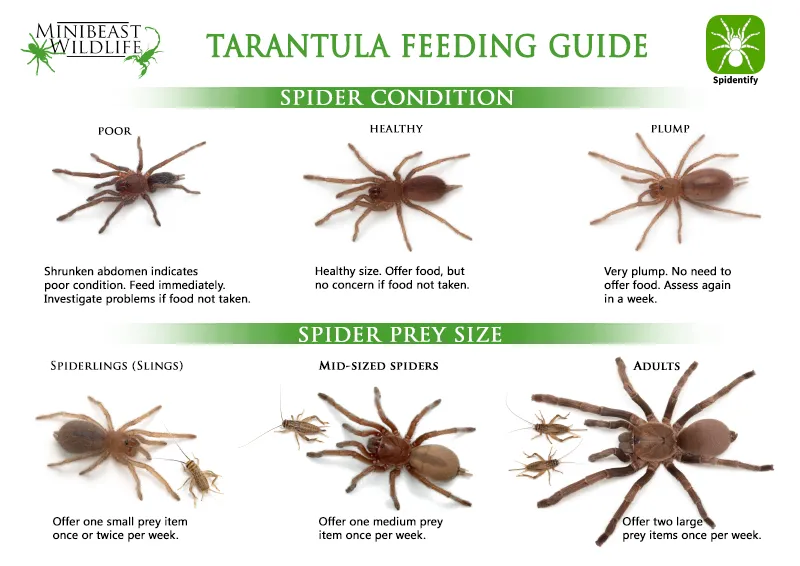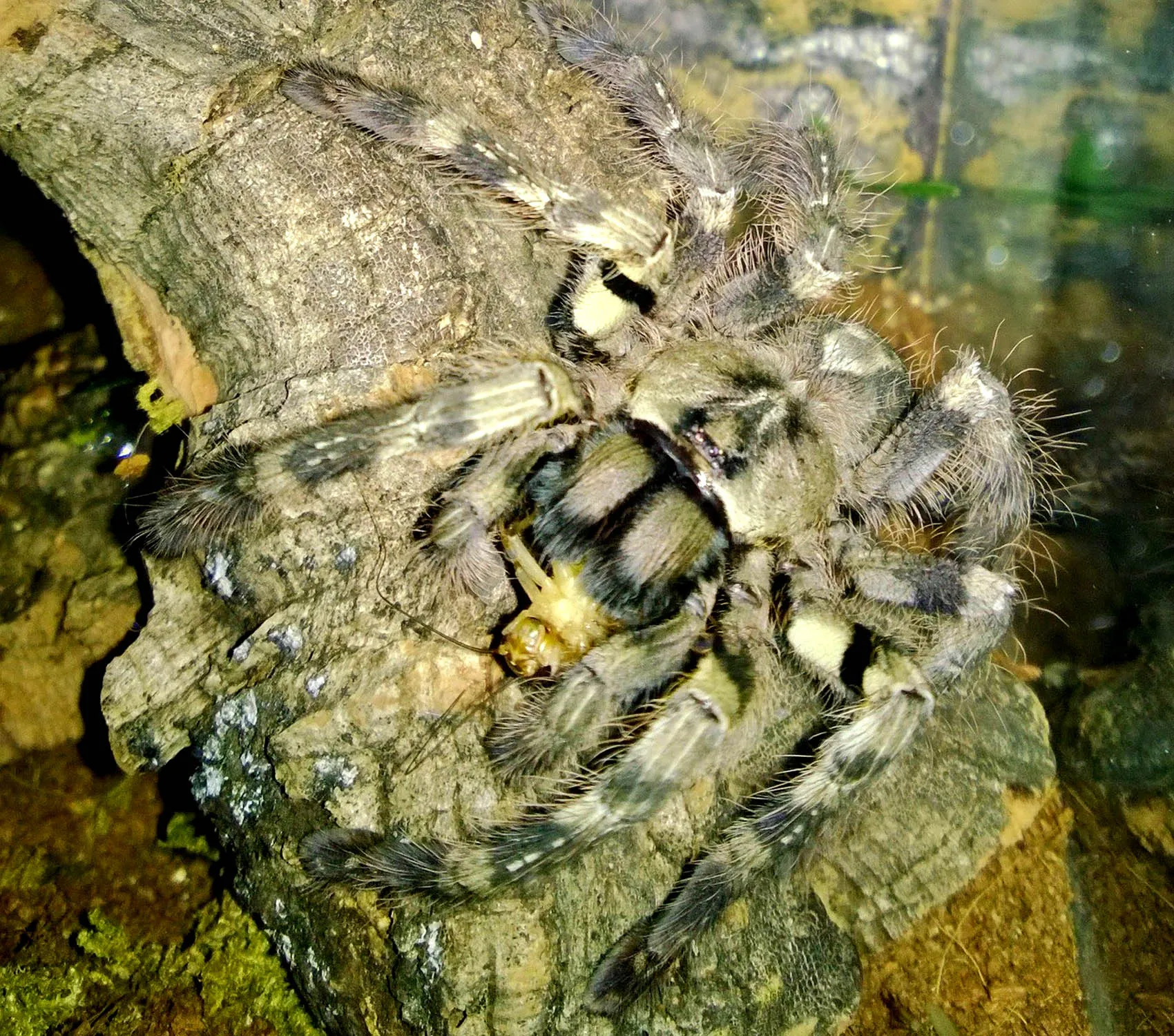Caring for a tarantula is a rewarding experience, but proper feeding is crucial for your pet’s health and longevity. This guide provides 101 quick tips to ensure you’re feeding your tarantula correctly, from the types of food they need to how often to feed them. Understanding your tarantula’s dietary requirements is essential for their well-being. We will cover everything from the basics of what tarantulas eat to more specific details like preparing food and recognizing signs of overfeeding. By following these tips, you can provide the best possible care for your eight-legged friend.
What Do Tarantulas Eat?
Tarantulas are primarily insectivores, meaning their diet consists mainly of insects. In their natural habitat, they’ll consume whatever insects they can catch. As pets, it’s your responsibility to provide a nutritious and easily accessible food source. Variety is key, but always prioritize live, healthy prey. Avoid feeding your tarantula anything that has been exposed to pesticides or other harmful chemicals. Ensuring your tarantula gets a well-balanced diet is key to its growth and health, contributing to a longer lifespan and fewer health problems.
Insects Insects Insects
Insects form the cornerstone of a tarantula’s diet. Crickets, roaches, mealworms, and other insects provide the necessary protein, fats, and nutrients that tarantulas require. Choose insects that are appropriately sized for your tarantula; the prey should generally be no larger than the tarantula’s body. Over time you’ll get a feel for what your tarantula prefers. Some owners try multiple food types to see what their pet enjoys, providing enrichment and varying nutritional intake. Remember to gut-load the insects before feeding them to your tarantula to boost their nutritional value.
Best Insects to Feed Tarantulas

The best insects to feed your tarantula include crickets, dubia roaches, mealworms, and superworms. Crickets are readily available and a good staple food, while dubia roaches offer a higher protein content. Mealworms and superworms can be given, but in moderation, due to their higher fat content. Always make sure the insects are from a reputable source to avoid introducing parasites or diseases to your pet. A varied diet is best, so rotating between these insects will help ensure your tarantula gets a balanced intake of nutrients. Remember to dust insects with calcium and vitamin supplements occasionally to improve their nutritional value.
How Often Should You Feed Tarantulas?
The frequency of feeding depends on your tarantula’s age. Spiderlings, juveniles, and adults have different feeding schedules. Overfeeding can lead to health problems, while underfeeding can stunt growth. It’s important to strike a balance and adjust the feeding schedule based on your tarantula’s specific needs and behavior. Always observe your tarantula; a tarantula that is refusing food may be preparing to molt, or it may simply not be hungry. Adjust the feeding schedule as needed, but in most cases, a consistent routine will keep your tarantula healthy and thriving.
Spiderling Feeding Schedule
Spiderlings, or baby tarantulas, have the highest metabolic rates and require more frequent feeding. Feed spiderlings 2-3 times a week. The insects should be small and appropriately sized to avoid overwhelming the spiderling. You may need to crush the insect’s head to prevent it from biting the spiderling. Use small, flightless fruit flies or pinhead crickets. Monitor the spiderling’s abdomen; if it appears plump and well-fed, you can reduce the frequency. Always make sure the food is fresh, and remove any uneaten prey within a few hours to prevent stressing your spiderling.
Juvenile Feeding Schedule

Juvenile tarantulas, which are in their growing phase, should be fed less frequently than spiderlings, but still regularly. A good rule of thumb is to feed them once or twice a week. Adjust the size of the prey as the tarantula grows. Young juvenile tarantulas might still eat small crickets, while larger ones can handle medium-sized prey. Ensure you don’t overfeed your juvenile tarantula; excess food can lead to health issues. Observe your tarantula’s behavior; if it’s consistently refusing food, it might be preparing to molt. Also, consider your tarantula’s species and activity level when planning the feeding schedule.
Adult Feeding Schedule
Adult tarantulas require the least frequent feeding. Feed adult tarantulas every one to two weeks. Some adult tarantulas may even eat less frequently. As adults, they have slower metabolisms and don’t require as much food. Overfeeding is a common mistake, so err on the side of caution. Observe your tarantula’s abdomen and overall health. If it appears healthy and active, the feeding schedule is likely appropriate. Remove uneaten food within 24 hours to avoid stressing your pet. Adjust the schedule as needed, paying attention to your tarantula’s behavior and any signs of molting.
How to Prepare Food for Your Tarantula
Preparing food for your tarantula involves several important steps. First, ensure the insects are healthy and have been gut-loaded. Gut-loading involves feeding the insects nutritious food before offering them to your tarantula. This enriches the nutritional value the tarantula receives. Always check the size of the prey to ensure it matches your tarantula’s size. Pre-killing the prey is another important preparation step, particularly for smaller tarantulas or those that are molting. Providing clean, fresh food is critical for your tarantula’s health and overall well-being. Regularly inspect the enclosure to ensure the environment is hygienic.
Pre-Killing Prey

Pre-killing prey is essential for several reasons. It ensures that the insect won’t harm your tarantula, particularly during a molt when the tarantula is vulnerable. It can also make feeding easier, especially for smaller tarantulas. There are several humane methods for pre-killing prey, such as crushing the head of the insect. Always ensure the prey is deceased before offering it to your tarantula. Pre-killed prey is also beneficial because it reduces the stress on your tarantula, providing it with a safe and secure feeding experience. Avoid offering live insects that might injure your tarantula.
Removing Leftovers
Removing uneaten food is crucial for maintaining a healthy environment for your tarantula. Leaving uneaten prey in the enclosure can stress your tarantula and lead to the build-up of waste. This can also attract mites and other pests, which can be harmful to your tarantula. Remove any uneaten insects within 24 hours of feeding. Regularly inspect the enclosure for any leftover food items. Use a pair of tongs to safely remove the remains of the insect without disturbing your tarantula. Cleaning the enclosure is essential to prevent the growth of harmful bacteria and maintain optimal hygiene.
Water and Hydration
In addition to food, tarantulas need access to fresh water. Provide a shallow water dish that is easily accessible. Ensure the water dish is always clean and filled with fresh water. This will help your tarantula stay hydrated and healthy. Spiderlings may require a small, shallow water source, such as a bottle cap filled with water. Regularly clean the water dish to prevent the growth of bacteria and algae. Monitoring the water levels is crucial, especially during dry seasons. Hydration is just as important as nutrition.
Signs of Overfeeding

Overfeeding can lead to several health issues for tarantulas. One sign of overfeeding is a plump or bloated abdomen. A tarantula may also become less active and less likely to move around its enclosure. Refusal to eat is another sign, as a tarantula might reject food if it isn’t hungry. Monitor your tarantula closely and adjust the feeding schedule if you suspect overfeeding. Adjust the frequency of feeding or reduce the size of the prey. Overfeeding can be just as detrimental as underfeeding, so pay attention to the signs and adjust your feeding accordingly.
Tarantula Molting and Feeding
Molting is a natural process where tarantulas shed their exoskeleton to grow. During this time, it’s crucial to adjust the feeding schedule. Do not feed your tarantula when it’s preparing to molt, or is in the process of molting, as it will be vulnerable. Offering food can stress the tarantula and may lead to injury. Signs of an approaching molt include the tarantula becoming inactive, losing its appetite, and the abdomen appearing darker. Provide extra moisture to facilitate the molting process, and avoid disturbing your tarantula during this time. Once the tarantula has molted, wait a week or two before resuming feeding, giving its new exoskeleton time to harden.
Feeding your tarantula correctly is critical to its well-being. Following these 101 quick tips will help you ensure your tarantula thrives. Always observe your tarantula’s behavior and adjust your feeding schedule as needed. Providing a balanced diet, proper hydration, and a clean environment are all key components of responsible tarantula care. By understanding the specific needs of your tarantula, you can provide a healthy and fulfilling life for your pet. Remember, patience and observation are essential components of tarantula care.
